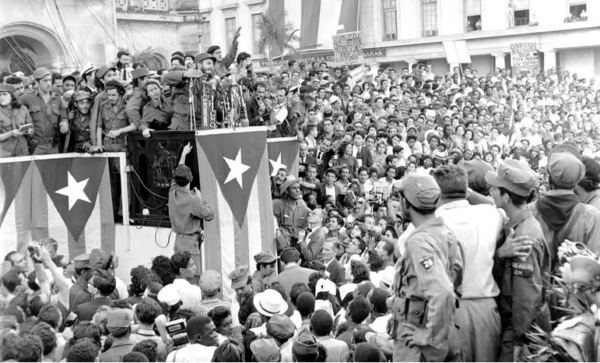Birth and First Steps

By Eduardo N. Cordoví Hernandez
HAVANA TIMES – In those glorious days of 1959 and the early sixties, in the Lawton neighborhood of Havana, as throughout the country, we were immersed in an atmosphere of euphoria. Everyone talked about the rebels and their leaders, who walked through the streets with their beards and their necklaces of Santa Juana, peony flowers and those other seeds called ox’s eyes.
In those glorious days…? Some may wonder and even others will think that it is my opinion. In reality, what I think is not important, because in reality, those days in 1959 were like that for the vast majority. Perhaps later they began to stop being so for some and today they are not perceived as so glorious because: some were small children and others did not perceive it at all because they had not even been born, and others because they have already died… anyway.
In those times an idyllic era of brotherhood seemed to begin, the birth of a better time full of justice, freedom, and peace, for which twenty thousand martyrs had been sacrificed according to malicious calculations. Later it was learned that there were not so many. Bohemia magazine published that, between both sides, there were less than three thousand. However, I am not going to write about that today, although in terms of sacrifices of this type, they already seem too many to me when I think that justice, freedom, and peace in themselves are quite debatable and very poorly understood matters.
In that year of triumph, the maximum leader reached the age of Christ. After the landing of the Granma yacht, twelve men alongside him had survived, after the dispersion that followed an air attack by the forces of the Batista dictatorship. Reminiscence of the twelve disciples of Jesus, a number beyond that, symbolic of perfect things.
Legends are woven around heroes. After they conquer glory, anything they do becomes a myth. It happens, as with lovers, the object of attention may be an eyesore, but it is found divine. Whatever you say, thank you. This is how humans’ function.
The highest rank of rebel officers was that of commander. All that bombastic nomenclature of the constitutional army: colonels, lieutenant-colonels, generals, brigadiers and admirals. Seen as something unnecessary, opulent, and exaggerated, it was abolished. The military barracks were converted into schools. The Police changed the traditional Prussian blue uniform for olive green. The Castillo del Principe was no longer a prison in the middle of the capital. The Modelo Prison, on Isla de Pinos, today Isla de la Juventud, became a museum. The prostitution neighborhoods and homeless people on the streets disappeared. Such changes and such mystical coincidences were promising signs of peace and momentum toward progress.
From the mid-seventies, there were, again, colonels and generals. It seems to be international regulations that the police wear blue, so one fine day, at the end of the eighties, the police dawned again dressed in this color. Beggars also began to be seen in Havana.
As for the matter of mysticism, peace and such, hopes did not progress. With the counterrevolutionary Bay of Pigs attack, the socialist character of the revolution was declared. Basic necessities began to become scarce, and it became necessary to establish a family ration book for food, which – remains to this day: November 2023 – and another for clothing that disappeared years ago.
Also, internal opposition emerged to overthrow the revolution, according to government sources, funded by the Cuban community exiled in Miami, and even the CIA. This opposition was fought in military terms under the name of the “Fight Against Bandits”. It never appeared as an honorable political-military opposition, not even with traits of deviant patriotism. They were mercenaries, murderers, and worms at the service of a foreign, imperialist, colonialist power… without any popular support. Although being such an insignificant enemy it had epic connotations.
During those times, an entire village of peasants was moved from Topes de Collantes, in Las Villas, to Pinar del Río, an operation similar to the mitima policy of forced resettlement of the Incas. Mandatory, in record time of effectiveness. Well, they arrived, the families moved to an empty town that was already waiting for them. I was not a witness. I learned about it from friends who lived through it and told me about it almost in confession. The operation had no subsequent publicity. It was known and commented on secretly. It was said that it was carried out for the safety of the peasants. Some suspected that it was due to the support that many gave to the rebels.
We also saw everything about the very long war in Viet Nam and the famous Che Guevara phrase: Create one, two, three, many Vietnams… as the only way to end United States’ hegemony. Therefore, there was no room for the promised peace. The present is about struggle and the future is ours, was another slogan that served to eradicate the dream of prosperous tranquility.
On the other hand, there were the terrorist actions, sometimes directed by the CIA, others by the so-called Miami worms, others by the internal counterrevolution, or by all of them at the same time. At least, that was how the government communicated it, according to its clues which led to such certainties.
In the depth of the chain of universal facts, in the invisible world where the true causes of reality occur, was the situation different? I only know that, in my soul as a romantic child reading Ivanhoe, Heart and Les Misérables, I always felt sorry that the Revolution did not have a worthy enemy; because without one what honor would there be in winning over ruffians.





